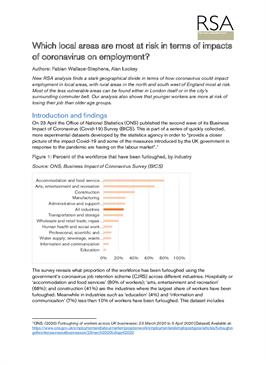This short briefing looks at how coronavirus could impact employment in local areas.
On 23 April the Office of National Statistics (ONS) published the second wave of its Business Impact of Coronavirus (Covid-19) Survey (BICS). The survey reveals what proportion of the workforce has been furloughed across different industries.
The RSA has mapped this data onto the industrial composition of different local authority areas to identify which parts of the country are most exposed to the labour market risks associated with Covid-19.
Our analysis finds a stark geographical divide, with rural areas located in the north and south west of England most at risk of high job losses. Many of these areas are national parks, coastal towns and other tourist hotspots where the economy is geared towards hospitality and retail.
Meanwhile, urban areas tend to be less at risk, particularly local authorities located in London or in its surrounding commuter belt. These areas have a more diverse local economy with a high concentration of jobs in ‘knowledge economy’ services that allow workers to easily work from home.
While there are clear hotspots of vulnerability, the small degree of variation between the most (Richmondshire, 35% of jobs at risk) and least at risk (Oxford, 19%) suggests that the impacts of Covid-19 will be widely felt across the country.
Our analysis also explores the vulnerability of different demographic groups. Our main finding here is that younger workers are overwhelmingly more likely to be furloughed – nearly twice as likely as middle-aged workers.
Download the briefing (PDF, 235KB)
Explore our interactive data map
pdf 234.8 KB
Contributors


